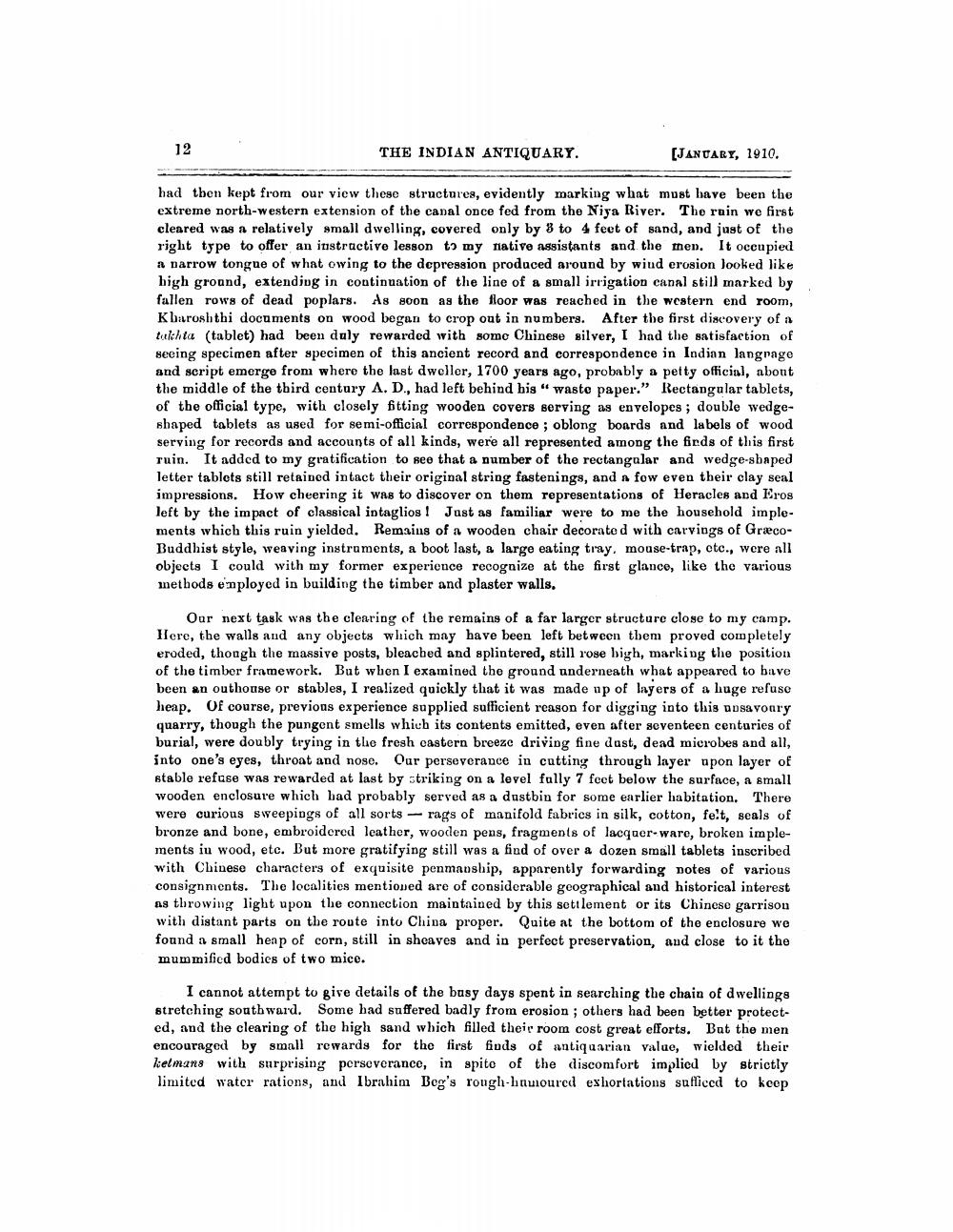________________
12
THE INDIAN ANTIQUARY.
(JANUARY, 1910.
had then kept from our view these structures, evidently marking what must have been the extreme north-western extension of the canal once fed from the Niya River. The rain we first cleared was a relatively small dwelling, covered only by 3 to 4 feet of sand, and just of the right type to offer an instructive lesson to my native assistants and the men. It occupied a narrow tongue of what owing to the depression produced around by wind erosion looked like high ground, extending in continuation of the line of a small irrigation canal still marked by fallen rows of dead poplars. As soon as the floor was reached in the western end room, Kbaroshthi documents on wood began to crop out in numbers. After the first discovery of a tukhta (tablet) had been duly rewarded with some Chinese silver, I had the satisfaction of seeing specimen after specimen of this ancient record and correspondence in Indian langrage and script emerge from where the last dweller, 1700 years ago, probably a petty official, about the middle of the third century A. D., had left behind his "wasto paper." Rectangular tablets, of the official type, with closely fitting wooden covers serving as envelopes; double wedgeshaped tablets as used for semi-official correspondence ; oblong boards and labels of wood serving for records and accounts of all kinds, were all represented among the firds of this first ruin. It added to my gratification to see that a number of the rectangular and wedge-shaped letter tablets still retained intact their original string fastenings, and a fow even their clay seal impressions. How cheering it was to discover on them representations of Heracles and Eros left by the impact of classical intaglios! Just as familiar were to me the household implements which this ruin yielded. Remains of a wooden chair decorated with carvings of GræcoBuddhist style, weaving instruments, a boot last, a large eating tray, mouse-trap, etc., were all objects I could with my former experience recognize at the first glance, like the various methods employed in building the timber and plaster walls.
Our next task was the clearing of the remains of a far larger structure close to my camp. Here, the walls and any objects which may have been left between them proved completely eroded, though the massive posts, bleached and splintered, still rose bigh, marking the position of the timber framework. But when I examined the ground anderneath what appeared to bave been an outhouse or stables, I realized quickly that it was made up of layers of a huge refuse heap. Of course, previous experience supplied sufficient reason for digging into this posavoury quarry, though the pungent smells which its contents emitted, even after seventeen centuries of burial, were doubly trying in the fresh castern breeze driving fine dast, dead microbes and all, into one's eyes, throat and nose. Our perseverance in cutting through layer npon layer of stable refuse was rewarded at last by striking on a level fully 7 feet below the surface, a small wooden enclosure which bad probably served as a dustbin for some earlier habitation. There were curious sweepings of all sorts - rags of manifold fabrics in silk, cotton, felt, seals of bronze and bone, embroidered leather, wooden pens, fragments of lacquer-ware, broken implements in wood, etc. But more gratifying still was a find of over a dozen small tablets inscribed with Chinese characters of exquisite penmanship, apparently forwarding potes of various consignments. The localities mentioned are of considerable geographical and historical interest as throwing light upon the connection maintained by this settlement or its Chinese garrison with distant parts on the route into China proper. Quite at the bottom of the enclosure we found a small henp of corn, still in sheaves and in perfect preservation, and close to it the mummified bodies of two mice.
I cannot attempt to give details of the busy days spent in searching the chain of dwellings stretching southward. Some had suffered badly from erosion ; others had been better protected, and the clearing of the high sand which filled their room cost great efforts. But the men encouraged by small rewards for the first finds of antiquarian value, wielded their kelmans with surprising perseverance, in spite of the discomfort implied by strictly limited water rations, and Ibrahim Beg's rough-havoured exhortations sufliced to keep




